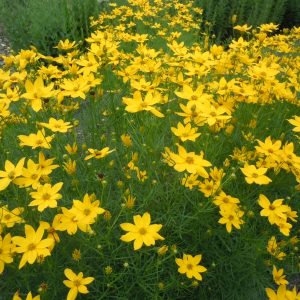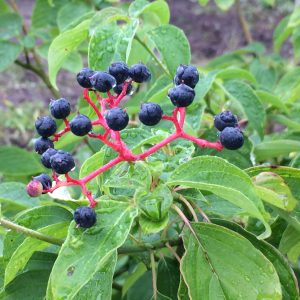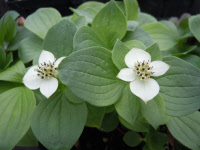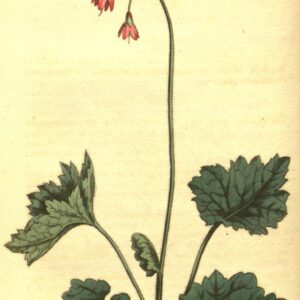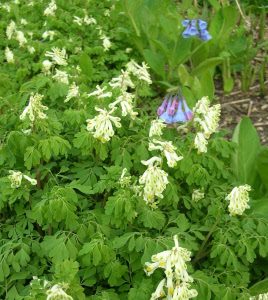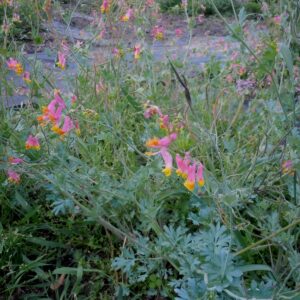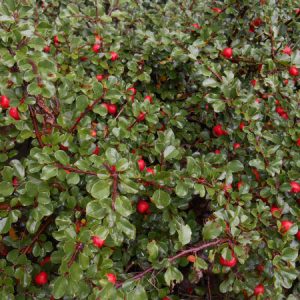Our Plants
Showing 153–160 of 587 results
-
Coreopsis verticillata Thread leafed tickseed Z 4-9
All summer into fall, free-blooming non-stop - yolk yellow daisies of 8 narrow spoon-shaped petals with a color matching center each atop a wiry stem. Cut back half-way to promote reblooming in fall.
All summer into fall, free-blooming non-stop – yolk yellow daisies of 8 narrow spoon-shaped petals with a color matching center each atop a wiry stem. Cut back half-way to promote reblooming in fall.
Size: 24" x 18" spreading
Care: Sun to part shade well-drained to moist well-drained soil, drought tolerant
Native: S.E. U.S.
Wildlife Value: attracts butterflies, Deer resistantNatives made a tea with the roots to remedy diarrhea and induce vomiting and a tea with the plant tops to make blood strong. A drink made from boiling the entire plant was used to remedy internal pain and bleeding. Also made a red dye and a yellow dye. Exported from its native America to England in 1759.
-
Cornus alternifolia Pagoda dogwood Z 4-7
Small tree with horizontal branches in flat tiers & a flat top, like the roof of a pagoda, bearing fragrant white flowers in early summer & blue berries on red stems against maroon leaves in fall.
Small tree with horizontal branches in flat tiers & a flat top, like the roof of a pagoda, bearing fragrant white flowers in early summer & blue berries on red stems against maroon leaves in fall.
Size: 15-30’ x 15-30’
Care: part shade in moist to moist well-drained soil – great understory tree.
Native: Canada to GA, west to MN – WI native
Wildlife Value: Hosts Spring azure butterfly caterpillar. Both food and shelter for Bluejay, Catbird, Chickadee, Flicker, Grosbeak, Junko, Oriole, Sparrow, Tanager, Thrush, Woodpecker, and food for more than 20 additional birds who eat the fruits.
Awards: Great Plants for Great PlainsAlternifolia means leaves alternating on stem. Cherokee chewed bark for headaches, sore throat, worms, measles & diarrhea. Poltice topically applied on ulcers & a decoction for colds & cough. Collected and described in writing before 1753. Grown at America’s 1st botanic garden, Elgin Botanic Garden 1811.
**LISTED AS OUT OF STOCK BECAUSE WE DO NOT SHIP THIS ITEM. IT IS AVAILABLE FOR PURCHASE AT OUR RETAIL LOCATION.
-
Cornus canadensis Bunchberry, Creeping dogwood Z 2-7Cornus canadensis syn. Chamaepericlymenum canadensis Bunchberry, Creeping dogwood Z 2-7
Four white, pointed petal-like bracts in spring and showy scarlet berries in fall
Four white, pointed petal-like bracts in spring and showy scarlet berries in fall
Size: 6” x spreading slowly
Care: part shade in moist, ACIDIC soil. Needs moisture to establish
Native: Northern areas from the east to the west coasts of No. America, Wisconsin native.
Wildlife Value: Host for the caterpillar of the Spring azure butterfly. Pollen and nectar for many bees, wasps, ants, butterflies and beetles. Deer and rabbit resistantFlowers open faster than any other flower, in less than ½ millisecond. Abnaki Indians used it to cure side pains. Algonquin made a cathartic tea, cured colds, and stomach aches with this. Delaware reduced body pains with it. Chippewa, Cree and Eskimo smoked the berries. Probably 1st collected for gardens by John Bartram (1699-1776). Offered for sale at his nursery near Philadelphia. Sent to Dr. Fothergill in London in 1774. “One of the prettiest plants for the bog garden or the cool parts of the rock garden.” William Robinson 1899. Pressed specimen in Emily Dickinson’s herbarium.
-
Cortusa matthiola syn. Primula matthioli Alpine bells Z 4-9
Demure purple, drooping bells atop a short scape arising from a low carpet of foliage in May-June.
OUT OF STOCK
Demure purple, drooping bells atop a short scape arising from a low carpet of foliage in May-June.
Size: 9” x 10”
Care: shade to part shade in moist soil
Native: AlpsDiscovered in a valley near Vincenza Italy in the foothills of the eastern Alps by Padua botany professor J.A. Cortusus. His friend Mattioli (1500-1577) named it for him and the species was named for Mattioli. According to Mattioli women used the leaves to color their cheeks pink: “the leaves applied to the cheeks, and shortly removed, occasion a beautiful colour, resembling that from the finest rouge. . .” Gerard grew this in London in the 1590’s but it was “at all times rare.” Profiled in 1807 in Curtis’ Botanical Magazine, plate 987
-
Corydalis lutea syn. Pseudofumaria lutea Yellow fumitory, Z 4-8
Clumps of canary yellow narrow tube-shaped flowers with flared ends bloom over mounds of ferny foliage from late spring – fall. Longest blooming shade flower
Clumps of canary yellow narrow tube-shaped flowers with flared ends bloom over mounds of ferny foliage from late spring – fall. Longest blooming shade flower
Size: 9-15" x 18"
Care: part shade to shade in moist well-drained to well-drained soil
Native: Throughout EuropeCorydalis is Greek for “lark” korydalos, referring to the shape of flower, a lark’s spur. Lutea means “yellow.” According to 16th century herbalist Culpepper, “Saturn owns the herb” so Corydalis lutea cured Saturn’s diseases of the liver, spleen, leprosy, scabs, itches, cholera, salty blood, jaundice, melancholy, plague, pestilence and red eyes. Greek physician Dioscordes authored 5-volume De Materia Medica writing that this “hinders fresh springing of hairs on the eye lids.”
-
Corydalis ochroleuca syn. Pseudofumaria alba Z 4-8
Clumps of crem white with a touch of yellow, narrow, tube-shaped flowers with flared ends bloom over mounds of ferny foliage from late spring – fall. One of longest blooming flowers for shade.
Clumps of cream white with a touch of yellow, narrow, tube-shaped flowers with flared ends bloom over mounds of ferny foliage from late spring – fall. One of longest blooming flowers for shade.
Size: 6-12” x 12”
Care: Shade to part shade in well-drained soil
Native: BalkansCorydalis is Greek for “lark” korydalos, referring to the shape of flower resembling a lark’s spur. This species published in 1831. Gertrude Jekyll (1848-1931) planted Corydalis ochroleuca as a “wide carpet” under peonies in her spring garden at her home, Munstead Wood.
-
Corydalis sempervirens syn. Capnoides sempervirens, Fumitory, Rock harlequin RESEEDING SHORT-LIVED PERENNIAL
Pink tube-shaped flowers with flaring yellow ends bloom from spring to summer
RESEEDING SHORT-LIVED PERENNIAL
Pink tube-shaped flowers with flaring yellow ends bloom from spring to summer
Size: 10-12” x 10-12”
Care: Sun to part shade in moist well drained soil
Native: from Nova Scotia west to Alaska, south to North Carolina, Wisconsin nativeCorydalis is Greek for “lark” korydalos, referring to the shape of flower resembling a lark’s spur. First described and named (name now changed) in 1753. Pressed specimen in Emily Dickinson’s herbarium.
-
Cotoneaster apiculatus Cranberry cotoneaster Z 5-7
White flowers followed by bright red berries lasting all winter. Glossy, leathery foliage tinges bronze in fall.
OUT OF STOCK
White flowers followed by bright red berries lasting all winter. Glossy, leathery foliage tinges bronze in fall.
Size: 3’ x 7’
Care: Sun in moist well-drained soil. Blooms on new wood so can prune in spring. Pruning promotes bushy plant and increased flowering.
Native: SW ChinaCollected by E.H.Wilson before 1916 who described it as “forming neat mounds . . . straddled with scarlet berries in the fall and winter.”
**LISTED AS OUT OF STOCK BECAUSE WE DO NOT SHIP THIS ITEM. IT IS AVAILABLE FOR PURCHASE AT OUR RETAIL LOCATION.

